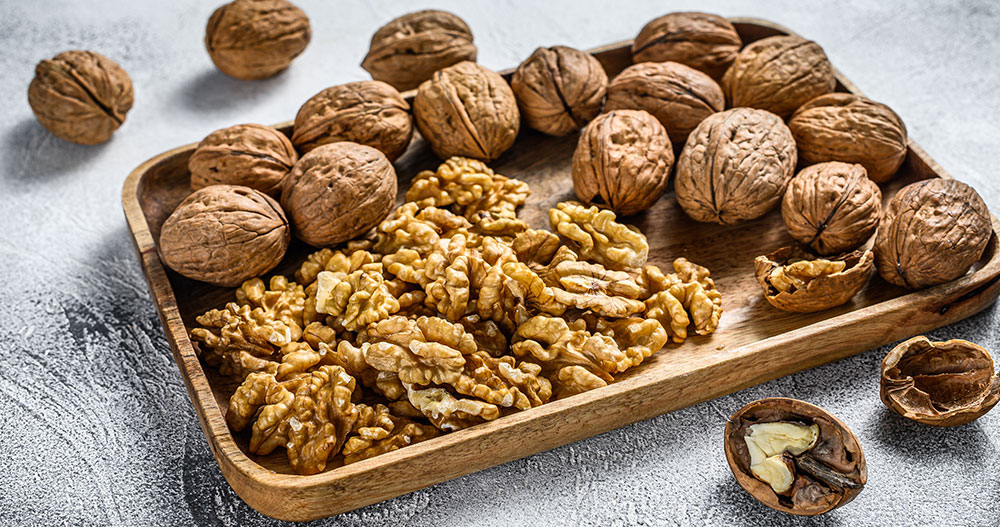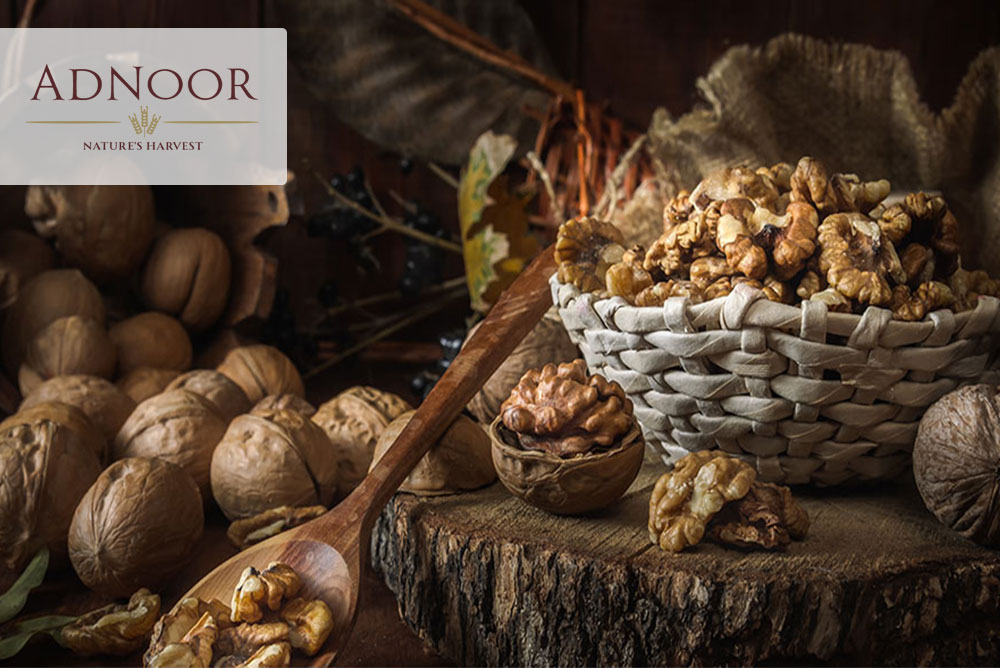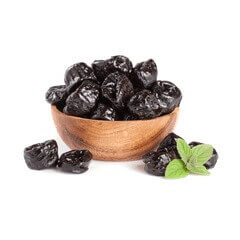Walnuts have a unique characteristic of having a high amount of polyunsaturated fatty acids, specifically omega-3s, which have been proven to benefit cardiovascular health. Due to the nut’s lipid content and other active ingredients, incorporating it into our regular diet can provide numerous health benefits.
Characteristics of Nuts
- Amazing source of Omega-3;
- Good source of minerals and vitamins.
- Rich in dietary fibre;
- Provide vegetable protein;
- Boosts cardiovascular health;
The Benefits of Nuts
Eating nuts and oilseeds can bring various health benefits, including reducing cholesterol levels, lowering the risk of cardiovascular disease and type 2 diabetes, preventing gallstones and gallbladder removal, and lowering the risk of colon cancer in women. In order to achieve these benefits, it’s recommended to consume about five one-ounce (30g) servings of nuts and oilseeds per week.
An Excellent Source of Polyunsaturated Fatty Acids
Walnuts are a great source of polyunsaturated fatty acids, with over 70% of their total lipids being comprised of these beneficial fats. Specifically, they contain alpha-linolenic acid, an essential omega-3 fatty acid, making them a great addition to a heart-healthy diet. Walnuts have an ideal balance of omega-3 and omega-6 fatty acids, which is important for maintaining good cardiovascular health. Studies have shown that including walnuts in your diet can help improve blood lipid levels and blood vessel elasticity, ultimately reducing the risk of cardiovascular disease. It is important to note that while polyunsaturated fats are helpful, they are not the only factor in protecting against heart disease. Other components in a balanced diet are also necessary for overall heart health.
Impact on Lipid Levels
Numerous studies have examined how consuming nuts affect blood lipids. In healthy individuals, incorporating 44 g to 84 g of nuts into their daily diet for four weeks reduced total cholesterol by 4% to 12% and LDL (“bad”) cholesterol by 9% to 16% compared to a nut-free diet. It’s important to note that nuts were not added to the diet but consumed instead of other lipids. Similar studies had also shown positive results in blood lipid improvement when nuts were introduced to individuals with hypercholesterolemia. In fact, consuming 41 g to 56 g of nuts per day for six weeks led to a 4% decrease in total cholesterol levels and a 6% decrease in LDL cholesterol. Daily nut consumption also resulted in a decrease in cholesterol levels in certain lipids-transporting particles that are considered atherogenic. In most studies, nut consumption did not significantly affect HDL (“good”) cholesterol and blood triglycerides. To summarize, consuming 40 g of nuts on a regular basis can positively impact blood lipid levels.

Cardiovascular Health
A study conducted on individuals with moderately high cholesterol revealed that substituting some of the dietary fat with nuts enhanced the elasticity of their vessel walls, which is crucial in preventing coronary artery disease. The exact mechanism behind this improvement is still unclear, but it is believed that alpha-linolenic acid and arginine, both compounds found in nuts, may contribute to this effect.
Antioxidant Power
Antioxidants are beneficial compounds that help reduce the damage caused by free radicals in the body. These free radicals are highly reactive molecules that can lead to the development of cardiovascular diseases, certain cancers, and other age-related illnesses. Nuts are an excellent source of antioxidants and rank second among many other plants, including fruits, vegetables, seeds, and cereals.
Nuts contain ellagic acid, which is a phenolic compound with antioxidant potential and has been shown to prevent certain cancers in animals. However, it’s important to note that these effects may not necessarily translate to humans. Research has found that the amount of ellagitannin (a phenolic compound containing ellagic acid) excreted in urine after consuming nuts varies from person to person based on microbial flora. This means that each individual metabolizes ellagitannin differently, and thus, the biological activity of this compound may differ from person to person. This information is valuable to bear in mind.
A Natural Source of Phytosterols
Phytosterols are compounds present in plants whose structure is related to that of cholesterol. A meta-analysis of 41 clinical trials has shown that taking 2 g of phytosterols on a regular basis reduces LDL (“bad”) cholesterol levels by 10% and that this reduction can reach 20% in the context of a diet. Low in saturated fat and cholesterol. Phytosterols are found in the oil of the nut, and the few varieties of nuts contain different amounts. For example, a 30 g serving of black walnut would contain around 35 mg of phytosterols, compared to around 23 mg for the same serving of walnut (the most commonly consumed). The latter is also one of the nuts and oilseeds with the lowest phytosterols content.
Additionally, the amount of phytosterols in nut oils varies from country to country, being higher for nuts from China and lower for nuts from the United States. It is practically impossible to reach this quantity of 2 g per day through food alone, and for the moment, some health authorities do not allow the marketing of foods enriched with phytosterols. However, even if the effects of walnut phytosterols have not been evaluated directly, it is possible to assume that the phytosterols present naturally in food remain interesting for cardiovascular health.
Arginine Content
Vegetable proteins have a different amino acid composition compared to animal proteins. They usually have more arginine and less lysine. A study on animals showed that including walnuts in their diet could reduce blood platelet aggregation and total blood cholesterol. This reduction in platelet aggregation helps prevent cardiovascular disorders and is linked to the low lysine/arginine ratio in walnuts. This ratio seems to be the determining factor in the observed effect. Walnuts have a high content of arginine, which the body uses to produce nitric oxide. Nitric oxide promotes the dilation of blood vessels, which is necessary for good blood circulation. This antiatherogenic effect has been demonstrated in humans, but not specifically after consuming nuts.
Dietary Fibre
Did you know that nuts are a great source of dietary fibre? These fibres are only found in plant products and cannot be digested by the body. Eating a fibre-rich diet can help prevent constipation, lower the risk of colon cancer, and even prevent cardiovascular disease, type 2 diabetes, and overeating. It’s recommended that women aged 19 to 50 consume 25g of fibre per day, while men in the same age group should aim for 38g per day.
Impact on Body Weight
Although nuts are high in lipids, studies have shown that consuming them does not necessarily lead to weight gain. In fact, a six-month study found that adding nuts to the diet actually resulted in a lower weight increase than expected, given the added calories. Two other studies found that consuming an additional 285-400 kcal in the form of nuts for six weeks did not lead to weight gain. Reviews of scientific literature also suggest that regular consumption of nuts and oilseeds is not associated with weight gain. This may be due to factors such as increased satiety, higher fibre and polyunsaturated fatty acid content, and incomplete lipid absorption. It’s important to note, however, that moderation is key.
Vitamin E and Nuts
Vitamin E is made up of eight active compounds: four tocopherols and four tocotrienols. Among these, alpha-tocopherol is the most biologically active, while the body does not utilize the others as effectively. Although alpha-tocopherol is found in small amounts in nuts compared to other shelled and oily fruits like macadamia nuts, almonds, and hazelnuts, gamma-tocopherol is the primary compound associated with vitamin E. Although the body less efficiently utilizes it, certain studies suggest that gamma-tocopherol may have a higher antioxidant capacity than alpha-tocopherol. Interestingly, the vitamin E content of nuts is said to decrease by approximately 30% after three months of refrigeration.
Nuts Identity Card
- Family: Juglandaceae;
- Origin: Eurasia;
- Season: September to November;
- Colour: Brown;
- Flavour: pronounced and unique.
Choosing the Right Nuts
When selecting walnuts, opting for those still in their shells is best to ensure freshness. Shelled walnuts can often go rancid due to exposure to air, which can affect the unsaturated fats in the nuts. You can also find pickled walnuts in delicatessens, which are young and tender fruits marinated in vinegar and enjoyed like pickles.
For Optimal Preservation
Store your walnuts in their shells at temperatures below 10ºC, even in the refrigerator, to keep your walnuts fresh. Walnut oil should also be kept in the fridge, and shelled walnuts should ideally be refrigerated at all times.
How to Prepare the Walnut
Walnuts are versatile in the kitchen and can be eaten as a healthy snack on their own. They can also be used in sweet and savoury recipes to add flavour and texture.
Before Going To the Kitchen
One way to enhance the flavour of nuts is to roast them before serving or incorporating them into a recipe. This can be done easily by placing the shelled nuts on a metal plate in an oven preheated to 185ºC (360°F) and cooking for approximately ten minutes until they turn a light brown colour and emit a pleasant aroma. Alternatively, nuts can be roasted in their shells in an oven set at 190ºC (375°F) for approximately twenty minutes. For those who prefer a smoother texture, making nut butter by blending the flesh for 4 to 6 minutes is possible until it reaches the desired consistency.
The Savoury Version of the Walnut
- For a delicious appetizer, try coating apple pieces or seedless grapes with a mixture of cream cheese (with a touch of blue cheese for added flavour) and crushed walnuts.
- In salads, you can use them in a classic Waldorf salad with endives and apples or in a salad with lamb’s lettuce, diced beetroot, kiwi slices, firm cheese, and minced endive.
- Another option is to use them in a spinach salad with bacon and citrus bits. You can also replace pine nuts with walnuts in pesto.
- Use a blender to mix walnuts, bread, and coriander leaves to make breadcrumbs for coating fish fillets or escalopes.
- In order to make a tasty stuffing for poultry, you have to mix breadcrumbs, diced apples, walnuts, shallots, an egg, thyme, salt, and pepper. You can even add pickled nuts for an extra kick.
The Sweet Version of the Nut
- Nuts are a crucial ingredient in various baked goods such as bread mixes, cakes, muffins, pastries, clafoutis, macaroons, and banana bread.
- They also add a delightful crunch to bread puddings with diced apples and raisins. Jams made with peach, plum, pear, or fig can also benefit from the addition of nuts.
- Additionally, nuts can be a great addition to mueslis, granolas, and other cereal preparations.
- The classic walnut and maple syrup pie, a staple in Quebec cuisine, is a must-try.
Contraindications and Allergies to Nuts
It’s important to note that while walnuts are generally great for your health, they may not be suitable for everyone. They are known allergens and can cause allergic reactions in sensitive individuals. Additionally, walnuts are high in oxalates, so those who suffer from urinary stones should limit their consumption. The Canadian Food Inspection Agency (CFIA) lists “nuts” as one of the main allergens, which includes all nuts and oilseeds. However, some people may be specifically allergic to nuts, and a study found that allergies to walnuts, pecans, and hazelnuts are strongly associated. It’s recommended that those with peanut allergies also avoid consuming other shelled and oily fruits, including nuts, as they have a high potential for causing allergic reactions and are often handled in similar ways.
A Little History
The Juglans genus consists of around twenty walnut tree species, all of which produce edible fruit. The most widely recognized species is the common walnut, also known as Juglans regia. It is native to southeastern Europe, the Himalayas, and China, where it was domesticated or where its ancestors were obtained. The common walnut spread to Europe through trade routes and eventually reached temperate regions in North and South America and Australia. Although walnut oil is not as well-known today, it was a popular ingredient in Middle Ages cuisine and remained a significant part of central French cuisine until the mid-19th century.
Adnoor is the perfect platform to get the best quality nuts, raisins, dried fruits, basmati rice, and seeds. We provide the best Wholesale Dried Fruits in Canada. We aim to provide our customers with the best quality products so they keep visiting us.








